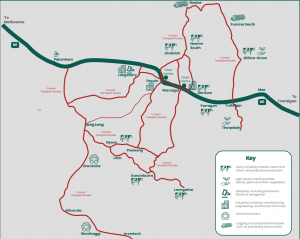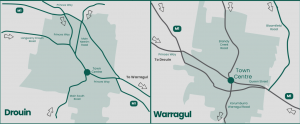Baw Baw Shire Outlines Roadmap for Key Infrastructure Projects
The lifeblood of regional Victoria relies on development of arterial roadways that not only connect far-flung villages with larger communities, but provide more efficient networks for commercial trucks and vehicles to ship goods from one region to another without creating major traffic congestion. As the fastest growing Peri-Urban municipality in Victoria, Baw Baw Shire’s ability to deliver, not only better connectivity between its 40+ communities to other parts of the region and beyond, as well as its ability to provide commercial vehicles with better bypass arterials, has fallen well off the pace. The townships of Drouin and Warragul have grown by 27% and 12% respectively, between the last two census periods. Indeed, with a population currently exceeding 50,000, Baw Baw Shire’s growth is expected to increase significantly nudging 100,000 by 2035, fuelling even more congestion and inefficiencies across its overburdened road networks.
Baw Baw’s Aging Arterial Network
The original road layout/network for Drouin and Warragul was started in the late 1800s at a time when no one could have anticipated the level of growth experienced today. The layout and arterial network have changed little since this time and clearly does not cater for a modern, growing regional area. In fact, the arterial road networks for both Drouin and Warragul run directly through the centre of each town’s CBD, which when combined with daily commuter and school drop-offs and pick-ups, means these towns have become ‘no-go’ zones for residents at different times each day.
Further, the topography of the area in and around these towns provides a challenge for the movement of heavy vehicles across the region and state. Due to the steep mountainous terrain of the Strzelecki Ranges to the south acting as an inhibitor for the safe, productive movement of heavy vehicle transport and freight from/to Baw Baw Shire to the southern areas of Gippsland – heavy vehicles are forced to travel directly through the centres of Drouin and Warragul.
Case Study – Construction Industry
As part of the growth within Baw Baw Shire, it is expected that there will be another 20,000 dwellings constructed over the next 15 years. This construction boom will require resources from extractive industries. An example of this will be the supply of sand and crushed rock for concrete. Victoria’s Extractive Resources Strategy shows that the major driver for demand for extractive resources is residential construction activity.
The need for extractive resources to cater for the residential housing demand within Drouin and Warragul will require the supply and transport of quarry materials, particularly high-quality sands, from the Grantville and Lang Lang area (see right). Transport from the Grantville/Lang Lang area to Drouin and Warragul is currently via Westernport Road, and the arterial network through Drouin and Warragul. Improving the flow of product via a more efficient arterial network that bypasses the residential areas of Drouin and Warragul and provides more direct access to commercial/industrial areas, is critical to facilitate the increased demand for residential construction materials/supplies, whilst improving accessibility and reducing transportation costs.
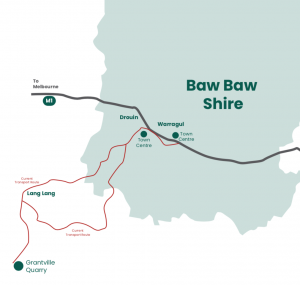
The impacts of the current arterial road network
Case Study – Dairy Industry
The Gippsland Region is a major contributor to Australia’s dairy industry, including Baw Baw Shire, Bass Coast Shire and Cardinia Shire to the west and south-west. The breeding of cattle is a necessary function required to support the dairy industry and as such the sale of livestock is critical. Over time, the number of saleyards across Gippsland has diminished to just three – Pakenham, Bairnsdale and Koonwarra. It is expected that the location of the Pakenham saleyards, and value of land where it is situated, will result in its eventual closure, leaving only two still operating. This would have a significant impact on the dairy industry, within West Gippsland, driving up the cost of primary production, due to increased transport costs, to transport livestock to/ from Bairnsdale (a three-hour trip from Drouin), or approximately 75 minutes for a trip from Koonwarra to Drouin. Longwarry, the neighbouring township to Drouin, has a planning application for the development of a regional saleyard. The proposal will provide a viable alternative in a strategic location that will best service Baw Baw, Cardinia and Bass Coast Shires. The need for improved connection from the south-west of Gippsland will be necessary to improve heavy vehicle access to the proposed saleyards site and minimise the impact on the residential areas of Longwarry and Drouin.
Baw Baw Shire is also home to numerous producers and manufacturers that process primary goods for domestic and international markets, including Fonterra’s milk processing facility, Flavorite Tomatoes and Jindi Cheese. The need for primary produce to travel from farmgate to these facilities, via a suitable heavy vehicle network, is essential to the continued diversity and transition of agribusiness within the Shire. The possible development of a third airport in the Caldermeade/Koo Wee Rup area will provide opportunity for produce from Gippsland to be exported by airfreight domestically and internationally. A future airport in this location will require the arterial network through Drouin to be upgraded, as this will become the shortest transport corridor for produce from Gippsland, including Baw Baw, to be transported to this facility. The increased freight that this would generate would have a major impact on the liveability of Drouin and Warragul, as well as the congestion in these townships affecting an impact on the productivity of freight travel and transport costs, if the challenges with the arterial network are not addressed.
The solution – A high level plan for the future
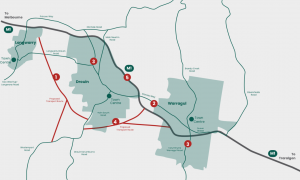
Key Highlights
1. Drouin (Western) Bypass
- Bypasses the residential area of Drouin to the west of the township improving access to the Drouin Industrial Estate, proposed Longwarry Saleyards and Industrial Estate and the Princes Freeway.
- Caters for the movement of livestock, extractive resources, agricultural produce from south-west Gippsland to key hubs.
- Improves economic productivity through increased overall accessibility and reduced transportation costs.
- Improves liveability and economic viability of Drouin CBD and retail centre.
2. Duplication of Princes Way (between Warragul and Drouin)
- Improved connectivity and arterial traffic flow between Drouin and Warragul.
- Improves liveability and economic viability of Drouin and Warragul CBD and retail centres.
- Improved safety.
- Improved access to education, employment and services.
3. Improved intersections
These intersections will improve access to growth zones, reduce the impact of heavy vehicles and improve safety. The following locations are recommended:
- Princes Way & Wellwood Road, Drouin
- Warragul Off Ramps; Howitt Street and Burke Street Intersections
4. Drouin (Eastern) Bypass
- Bypasses the residential area of Drouin to the south-east of the township improving access to Princes Highway and commercial precincts such as Warragul and major producers in the eastern part of the Shire.
- Caters for the movement of livestock, extractive resources, agricultural produce from south-west Gippsland to key hubs.
- Improves economic productivity through increased overall accessibility and reduced transportation costs.
- Improves liveability and economic viability of Drouin CBD and retail centre.
5. Buln Road Interchange Dollarburn Road Extension (Warragul Bypass)
- Bypasses the residential area of Warragul to the west of the township. This provides improved access to the industrial area of Drouin, proposed Longwarry Saleyards and Industrial Estate and the Princes Freeway.
- Caters for the movement of livestock, extractive resources, agricultural produce from north and north eastern areas of Baw Baw to key hubs.
- Improves economic productivity through increased overall accessibility and reduced transportation costs.
- Improves liveability and economic viability of Warragul CBD and retail centre.
- Improved safety within the Warragul township area.
Our Community (today, and tomorrow!) needs your support
According to Infrastructure Australia, there are major economic and social benefits from early action by government to protect transport corridors and acquire land in advance. Baw Baw Shire Council has developed a high level plan of the future transport needs and corridors that are required to minimise the impacts of freight on the character and liveability of these towns, while building a freight network that is safe, efficient, productive and drives economic growth for the Shire, Region and the State. Council is advocating for State and Federal Governments to commit to funding necessary transport planning (estimated at $3 million) to realise this plan, and the significant social and economic benefits that it will provide. This funding will therefore provide a detailed blueprint to enable the necessary project investment to secure Baw Baw Shire’s and the townships of Drouin and Warragul’s futures. These developments and investments in turn not only make the arterial road/transport network more efficient for Baw Baw Shire’s two largest communities, but will ultimately have major flow through benefits for the economic viability and sustainability of Gippsland and for the State of Victoria.
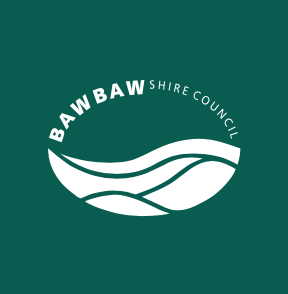
Partnerships
Potential Partnerships Government
- Regional Roads Victoria
- Victorian State Government
- Federal Government
- SEATS
- Roles from each partner could include funding, planning, support, advocacy and advice.
Potential Partnership Industries
The industries to benefit from a Drouin bypass include:
- Agriculture including beef, lamb, horticulture
- Forestry
- Mining
- Manufacturing
- Construction
- Professional Services

Transport/General Freight

Agriculture

Dairy

Quarrying

Mining

Manufacturing

Tourism
Key Attributes
Impacts on Liveability and the Local Economy
Barrier to Growth
The Drouin Township Plan highlights that one of the major barriers to the Drouin CBD, transforming into a vibrant, liveable, economically sustainable business and retail area , is the Princes Way and Main South Road running right through the heart of the retail shopping strip.
Limited Commercial Investment
This has resulted in limited private commercial investment into the township over the years, many retail premises being vacant and prime commercial land remaining undeveloped.
Prioritise Residents over Heavy Vehicle Traffic
The presence of arterial traffic, including significant volumes of large, freight-carrying heavy vehicles within the township, is impacting the economic viability of the CBD area, as the arterial network prioritises the movement of vehicular traffic over pedestrians and retail shoppers.
What makes Baw Baw home?
It is the Baw Baw Shire Council’s vision to have “Happy, healthy people sharing prosperity and knowledge from living sustainably and in harmony with our rural identity, thriving villages, productive and inspiring landscapes”. The essence of this vision is that residents will enjoy a high quality of life, underpinned by life within a township that maintains a rural community character and amenity. At the same time, residents will be provided with the socio-economic fabric to support community, employment and jobs within the local area and across the Shire. The risk and likelihood – in the absence of a long- term plan to resolve the issues with the State Government’s arterial network is that the Shire becomes a place of dormitory townships, where the rural sense of community is lost, with limited local economic opportunity to create jobs. It is therefore the vision for Baw Baw Shire now and into the future to support a thriving local economy that can support the rapid residential growth within these townships.
Impacts on Comparative Advantage
Increasing Workforce Pressures
The need to move a substantial workforce between the townships of Drouin and Warragul and the commercial/industrial districts to support the jobs for our growing population are critical. Unfortunately, the current arterial network cannot sustain the level of traffic that will be generated.
Business Challenges
Without this investment, Baw Baw Shire risks businesses moving and future businesses overlooking the Shire due to congestion and transport costs making setting up business in Baw Baw prohibitive.
Inadequate Transport Routes
It is expected that the key commercial and industrial areas that will be the generators of heavy vehicle traffic will be forced to use an insufficient arterial network, within the townships to access the primary freight route- Princes Highway.
What does investment mean for our future economy?
The vision for Baw Baw Shire now and into the future is to support a thriving local economy that can support employment for our residents. Strategies to support this, include but are not limited to, the re-zoning and expansion of industrial land in the Longwarry township, including the development of a regional scale saleyards; expansion of the commercial and industrial precincts in Drouin and Warragul, and the continued attraction of service sector businesses to the area. Without future investment in the arterial network within Drouin and Warragul to enable better and safer access to current and future commercial/industrial areas, Baw Baw Shire will be at a significant comparative disadvantage.
Trafalgar Crossing Removal: Removing the Trafalgar level crossing will address general road safety, and efficiency and productivity issues experienced by the local agriculture industry and commercial vehicle operators. It is anticipated road accidents will be reduced.
Impacts on Freight and Economic Productivity
Our Rich Agricultural Industry
Gippsland is rich in primary resources, has a strong agricultural industry, a skilled workforce, wonderful natural assets and huge potential that improvements to transport infrastructure would provide.
Inadequate Transport Routes
Inadequate transport infrastructure is a major impediment to the growth and prosperity of our region and this is evident in the movement of transport and freight, travelling through Drouin and Warragul to reach or travel from destinations east, south and south west of Baw Baw.
The Broader Impacts
The insufficient arterial transport network within Drouin and Warragul has broader transport and freight implications at a regional and state level.
Letters of Endorsement
- Mayor of Baw Baw Shire
- Chair of SEATS
- Owner of transport company
- Baw Baw Shire Business Chamber
In partnership with…



